Puget Systems Deluge Mini: The Art of Custom
by Dustin Sklavos on April 5, 2011 4:15 PM EST- Posted in
- Systems
- Intel
- Sandy Bridge
- GTX560
- Puget Systems
- NVIDIA
Application and Futuremark Performance
The principal comparison we're going to want to make here is against Origin's Genesis. Origin includes an SSD in their review system which is going to wildly skew PCMark results in their favor, even more so than the i7-2600K running at an identical clock speed to the Deluge Mini's i5-2500K. When we get to gaming, we'll see the difference is negligible in practice, but for programs that are heavily multi-threaded (as our application suite is) the Hyper-Threading on the 2600K is liable to produce a moderate lead.
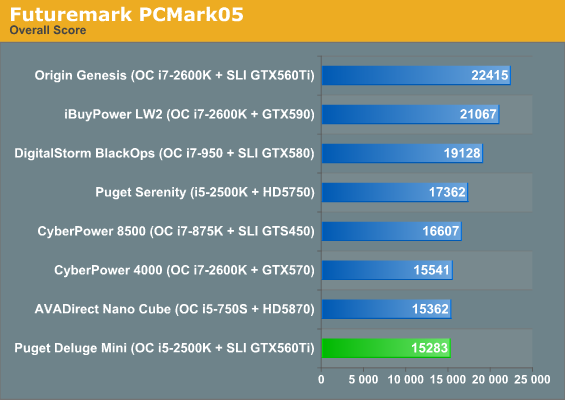
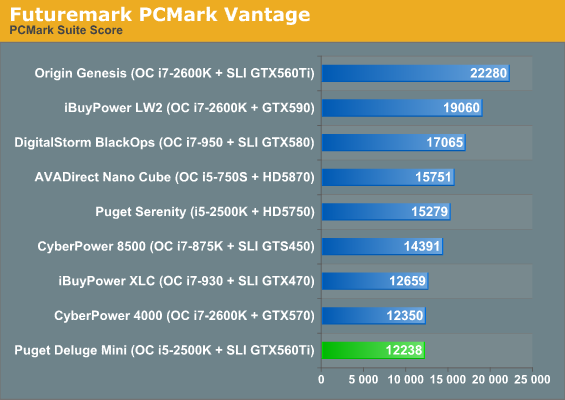
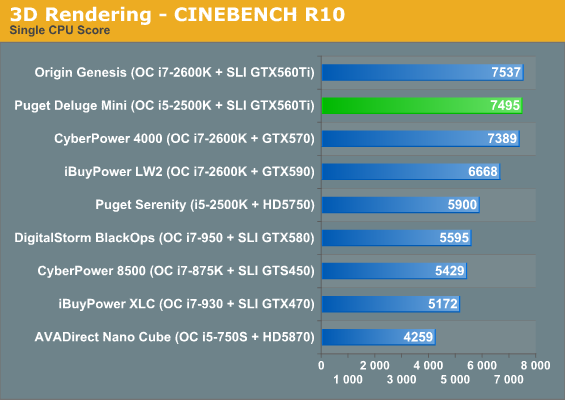
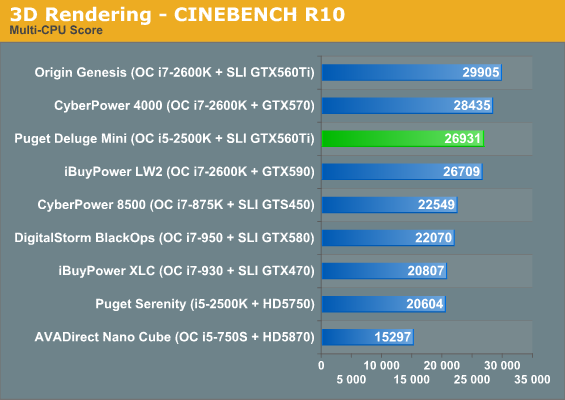
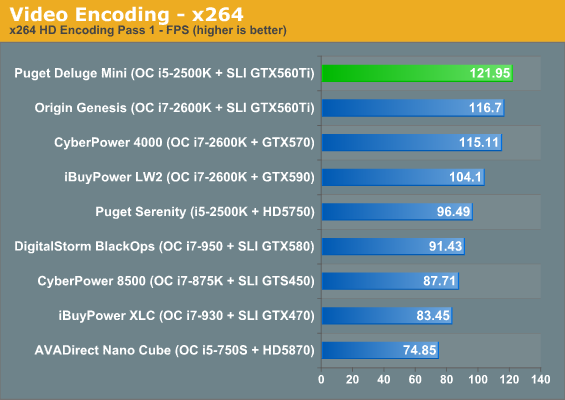
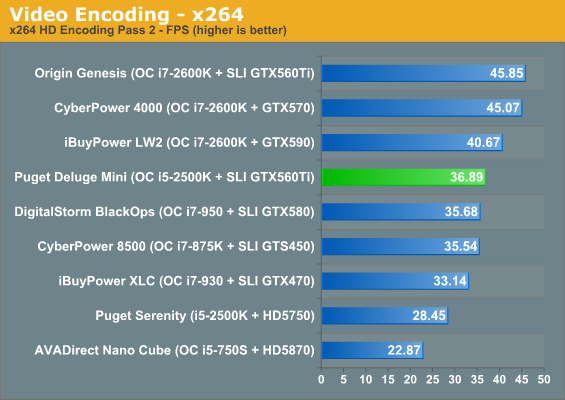
Our predictions are essentially proven correct here: PCMark skews wildly towards the SSD-equipped machines despite the i5-2500K being measurably faster than the previous generation i7's by no small margin. When we get to Cinebench and the x264 benchmark, Puget's 4.5GHz i5-2500K generally falls in right where we would expect it to (with the x264 pass 1 encode being oddly faster than the other systems). At some point it'll become less surprising how monstrously fast Sandy Bridge is, but I've played with six SB-based desktops at this point and each one still makes me want to throw my overclocked i7-930 out the window.

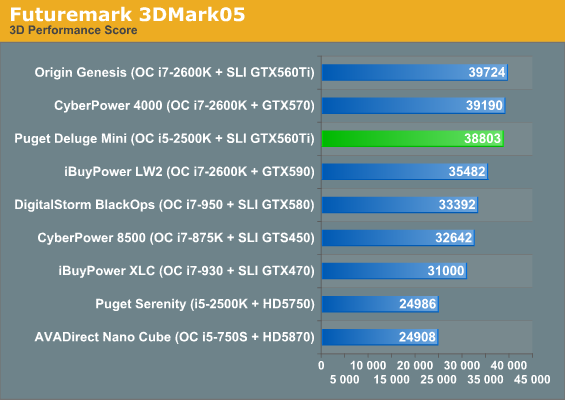
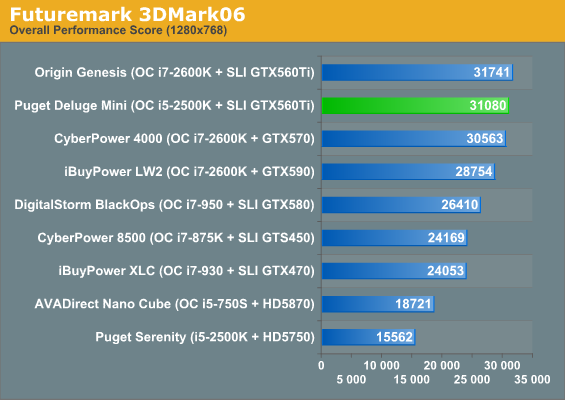
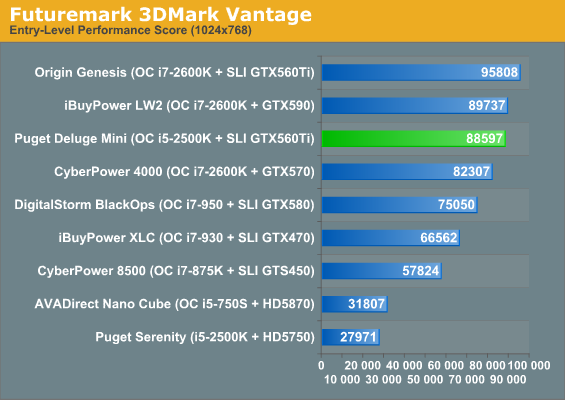
Given the way 3DMark's results can skew towards being CPU-limited by Sandy Bridge we're becoming increasingly less enamored with it. Independently as a reviewer I can tell you exactly how these configurations should be ordered in terms of gaming performance, and out of all four of these tests the only one that looks the closest to correct is 3DMark03. That flies in the face of "newer is better"; what do you guys think? Are these still useful or is there some change that should be made?










25 Comments
View All Comments
Velotop - Tuesday, April 5, 2011 - link
I may have to think twice about building my own. Plenty of research time saved with something like this one.michal1980 - Wednesday, April 6, 2011 - link
Why? Just use their 'research' and save a few hunderd bucks. I priced out one of their systems vs newegg, and the difference in price was ~400+ bucks. The only thing missing was their water cooling system. Which is worth what? a 100 bucks max.for 300 bucks, you can get a very decent size ssd a
RaistlinZ - Tuesday, April 5, 2011 - link
For $2,200.00 there's no reason not to have at least small SSD in conjunction with the 1TB WD Caviar Black. I really like the system overall though, and that case is sexy.bplewis24 - Tuesday, April 5, 2011 - link
That was my initial thought as well. I understand there is a premium for them building it, so $100-200 over cost seems reasonable. I'm curious as to how much the liquid cooling adds to the cost. I would likely do away with one of the GPUs and liquid cooling to get it a bit cheaper.scook9 - Tuesday, April 5, 2011 - link
I love this case. For 3 years my desktop was in a Mini P180. It can house 2 full length graphics cards easily with the bottom cage removed and even can fit 3x 1.120mm radiators if you want to watercool (I did it :D)This post has all the pictures of the various incarnations I crammed into that case
http://forum.notebookreview.com/notebook-cosmetic-...
jigglywiggly - Tuesday, April 5, 2011 - link
They just ruined the case by adding that fan on the side, the case is so quiet otherwise... sound dampening materials etc.HangFire - Wednesday, April 6, 2011 - link
Hmm, the review says "one of the quietest gaming desktops we've ever tested", "noise is virtually a non-issue", and "major victory" on "both better thermals on the CPU and much better acoustics".I'm trying to find the "just ruined" in here.
When I build a quiet system I avoid side fans, because it is difficult to keep the side panel from becoming a sounding board and amplifying the noise of the fan mounted on it, and also because the left panel is highly likely to be in line of site of the user's ear.
However just being difficult doesn't mean it can't be done, and it appears Puget Sound has done it, and did it well.
sully213 - Wednesday, April 6, 2011 - link
I have to agree that the side fan is adding "noise", but visual noise, not auditory noise. They can keep the fan itself there, internally mounted, but do away with the ugly fan grill and have a honeycomb or some other pattern of holes for the air to flow through. It provides the same amount of air flow without having a distracting and cheap looking grille mounted to the outside of the otherwise smooth visual line of the case.strikeback03 - Wednesday, April 6, 2011 - link
I agree, if the fan substantially helps temps I'm all for including it, but a black honeycomb/mesh grille mounted from the inside would look a lot less cheesy.Also, isn't this essentially the same watercooling system you complained about in the Origin system? Any idea why it is so much quieter here? And is it only the overclock resulting in the large differences in power consumption?
A5 - Tuesday, April 5, 2011 - link
For the lazy enthusiast, you could just order the base system (with an SSD if you want it - reinstalling Windows after the fact is kind of a pain) and then add in the 2nd card for SLI later, do the OC yourself, and get a big drive for storage on your own to save some coin and avoid the markups. You'd still pay a decent premium, but at least you'd know it worked when it got to your door.